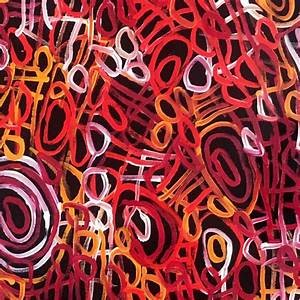Gond, a tribal art of India and Australian Aboriginal art are both visual storytelling mediums, the canvasses become a witness to years of history; bearing philosophy, culture and guarded knowledge.
Venkat Raman Singh Shyamoth , an important contemporary artist of our age while taking about the similarities between Indian tribal art forms like Gond and Bhil and Australian Aboriginal art discusses the shared history and geography. He explains that the similarity in themes and representation comes from the very fact that Aborigines have their own stories about creation just like we do, and they too present it through dashes and dots. He also traces geographical confluence between the two communities and is of the opinion that Gond is very similar to Aboriginal art for the simple reason that the Aboriginal art and Gond art have their geographic connection as well. Both are originally from the same continent of Gondwana. He says of the time, “...when there were just two continents, Gondwana and Laurasia. India and Australia came from Gondwana and America came from Laurasia.”
This interesting way of putting the concept of common shared history of all humanity also finds resonance in the idea of Collective unconscious, a term coined by twentieth century’s famous psychoanalyst Carl Jung. It is the idea of an analogous history because the structures of the unconscious mind are shared among organisms of the same species. As per Jung, certain instincts run human being’s unconscious collectively, this is the reason for existence of universal symbols, called archetypes such as The Noble Mother, the Wise Elderly Man, the Tree of life etc. Most of these archetypes can be observed in both Indian and Australian tribal art.
The dots and dashes for the Gond community are representative of the sum total, they stand as a microcosm of the entire world, and similarly the Australian art too tries to weave stories of its own understanding of human existence and their role on earth. It is also said that dot painting originated from the time of white Australian settlement where secret knowledge was protected closely and fiercely by the Aboriginal people, by coding stories that could be only decoded by members of the same community. This later became a part of their technique.
The use of striking colours is common to both art forms as well; the Gonds believed that painting their houses and walls with bright hues would herald good luck. Yellow, red, black and white dominate a Gond canvas, these were traditionally extracted naturally from organic and easily available sources. ‘Chui Mitti’, the local sand helps in creating yellow hues, ‘Gheru Mitti’ is used for creating the brown colour. Black colour is obtained from charcoal, plant leaves add green and Hibiscus is used for getting the bright red shades.

The sacred Aboriginal colours are said to have been given to the Aborigines in a ‘dream’, there are also Red, Black, Yellow and White. Black is representative of the earth. Red represents fire, energy and blood; these provide strength to the living. Yellow is used to represent water. White stands for the sky and the stars, the sky is usually painted filled with stars which are said to be Aborigines ancestors who are believed to have returned to the sky after taking part in creating earth.

These here are paintings by Charmaine Pwerle, who uses these stunning colours to represent an energetic aspect of dreaming. Dreaming, an intrinsic idea of aboriginal philosophy is often defined as the ongoing process of creation that unifies the past and present to determine the future.
Visually comparable to this are Gond paintings by the artist Rita Shyam, who beautifully illustrates various birds, abstract patterning on the body of the birds keeping the visual interest of the painting intact and very similar to Australian Aboriginal art. Rita Shyam is an artist associated with CCDF, she has been mentored and encouraged to explore the abstractness of this art form to make it much more suited to contemporary tastes without losing indigenous flavor.

These two art forms are divided by miles and miles of physical distance between their creators but are closely united and connected in its sentimentality and emotional core which are the definitive features of any art form.
This article is shared by Craft and Community Development Foundation and is authored by Shreya Seth.
References:
https://sunitanair.in/Gond-art-and-Aboriginal-art
https://indiantribalheritage.org/?p=17214
https://www.aboriginalartuk.com/post/2017/11/21/aboriginal-culture-scared-colours

